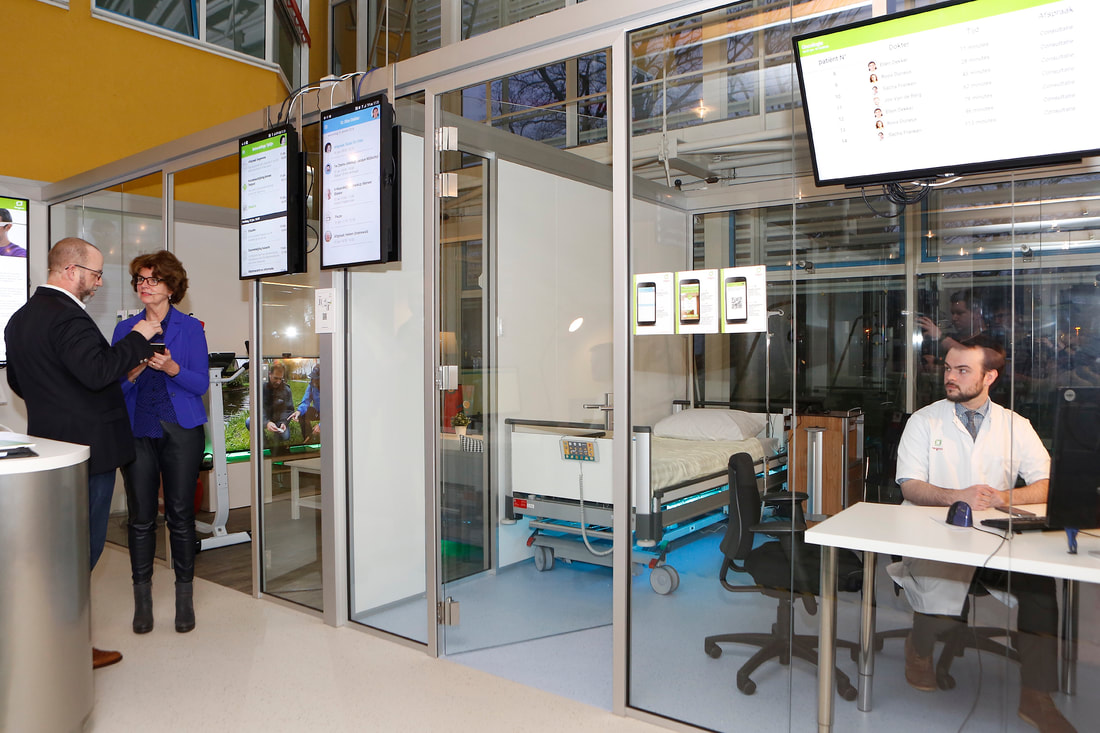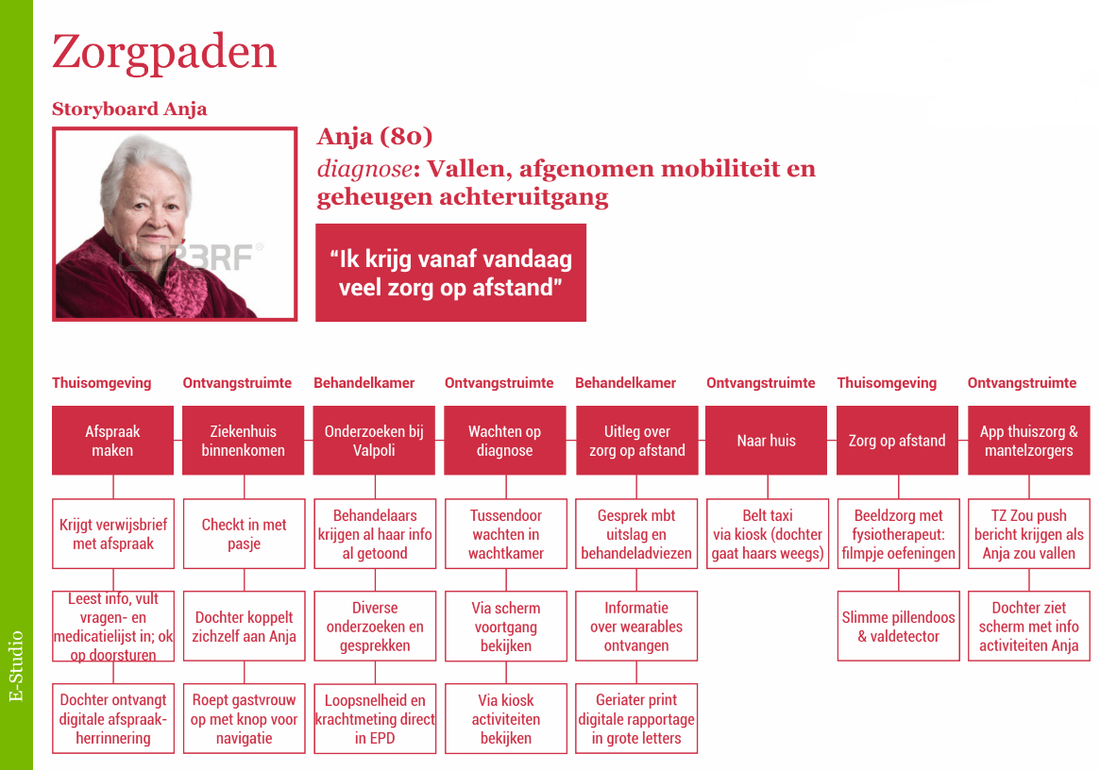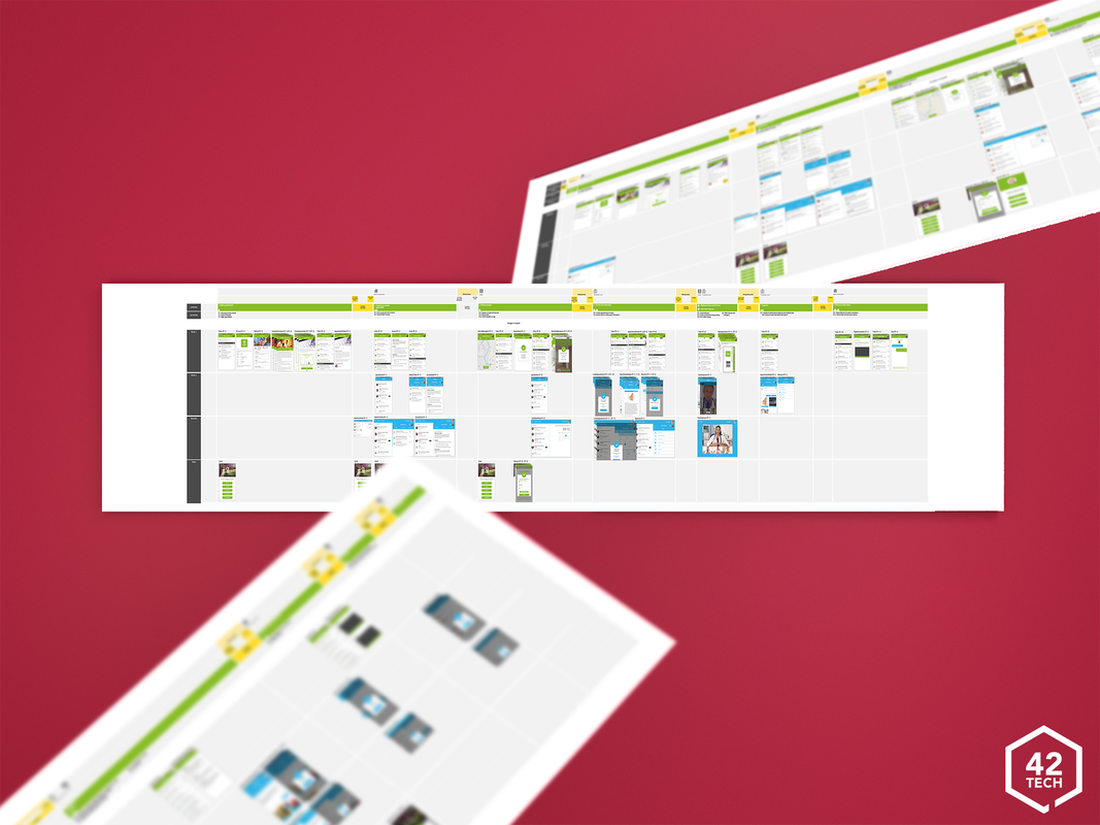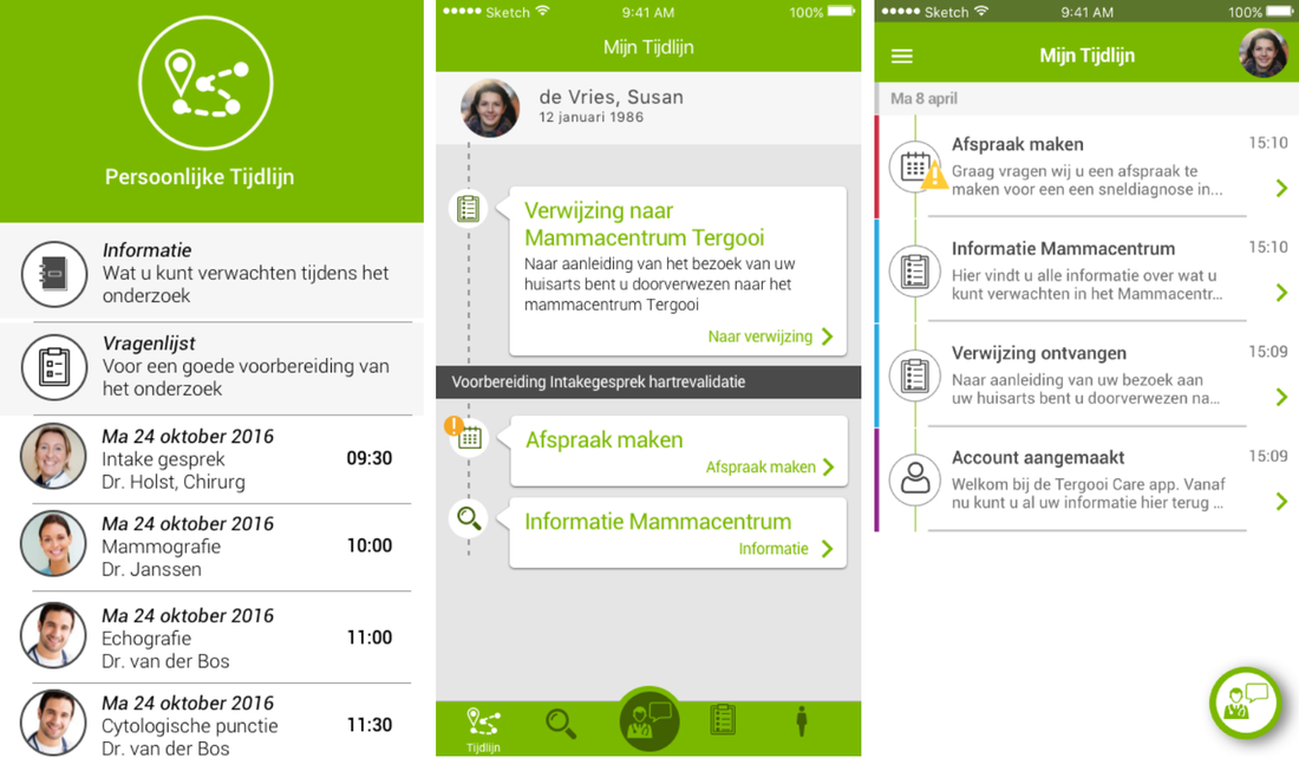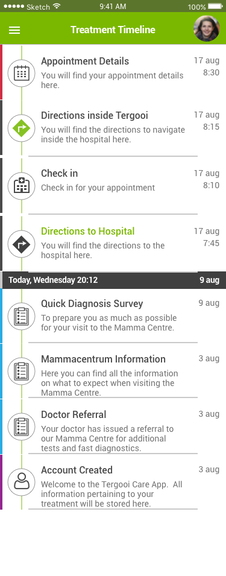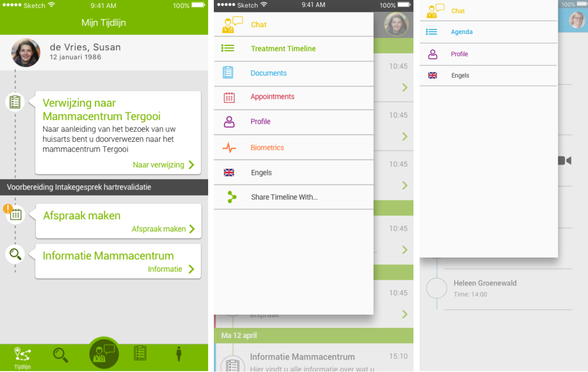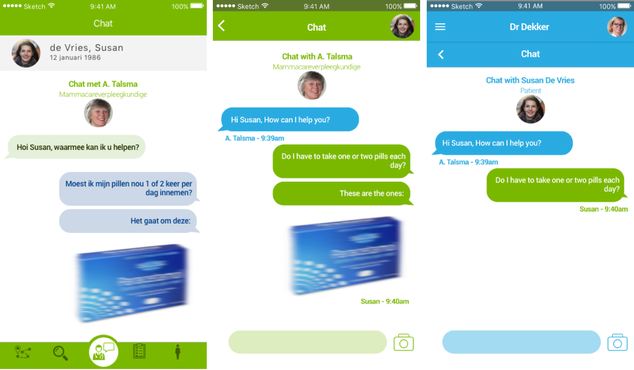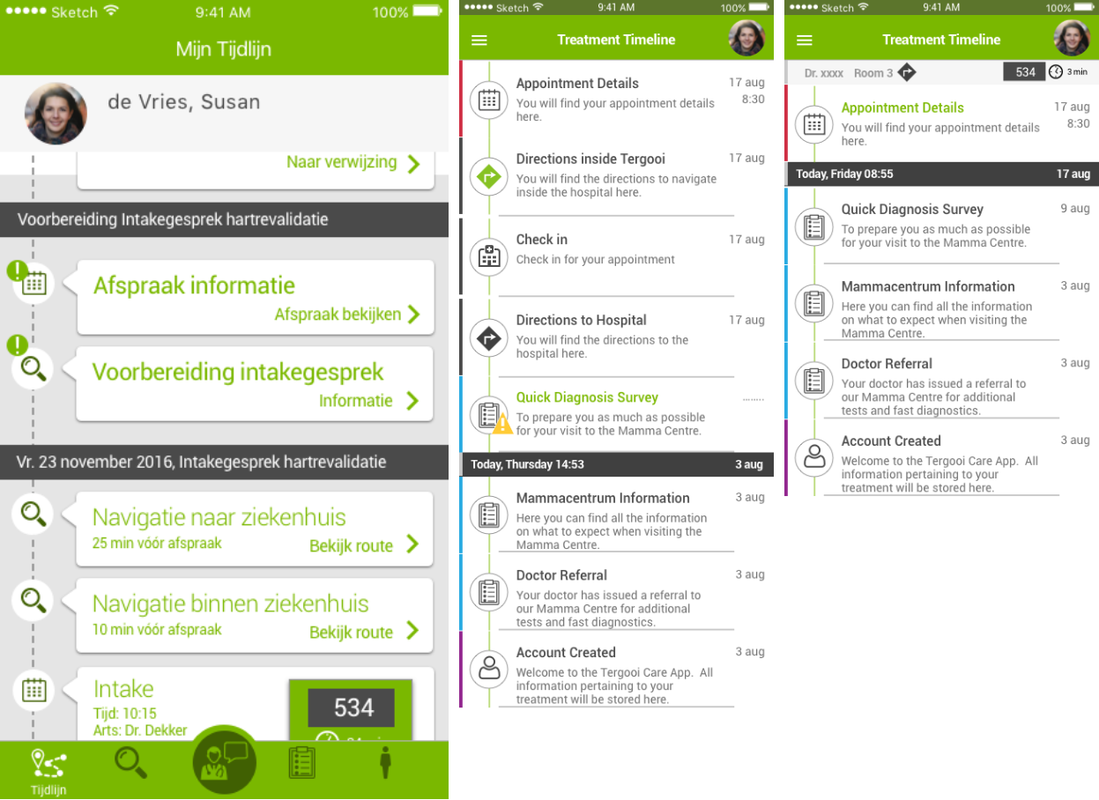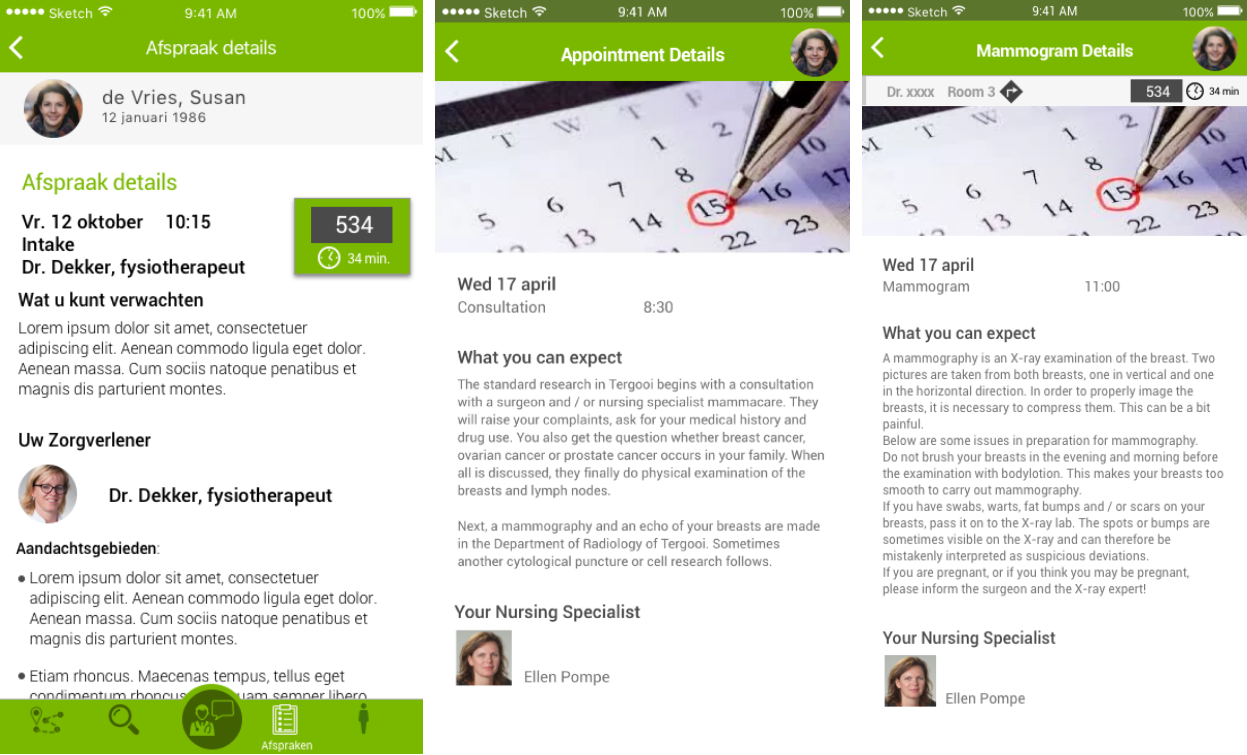E-Studio at Tergooi
An innovation hub of E-Health showing how the future could improve the patient and caregiver journey.
The premise of the E-Studio was for visitors / members of the public / staff of the hospital to select a patient and go through their journey at the hospital. There are multiple devices seen in the E-Studio, but the tour revolves around the two mobiles. One mobile phone is used by the tour guide who takes the role of the caregiver in the journey, the person coming on the tour gets the other phone and is put in the patient’s shoes. The E-Studio is designed to show how the healthcare system could be in 5+ years and open discussions about what could be implemented currently and what the industry can work towards. A holistic yet modular system that could be installed at hospitals to further help those going through treatment.
We had five personas taken from research at the hospital we were working with. Each represented a different type of patient seen at the hospital, from illness, to age, gender, treatment plan etc. The treatment timeline for patients was divided into the following sections: research & diagnosis, treatment, recovery and rehabilitation. The five personas showcase different sections of this treatment timeline. Working with the hospital, the rough stories of the five patients were drafted from what they would go through, with some extra parts added to capture the routine of a visitor to the hospital.
These five patients are important as the person visiting the E-Studio selects a patient of their choice and sees their journey and how the system works for them. Both doctor side and patient side change to show what features are available for this kind of care.
From workshops, interviews, and observational study with both doctors and patients, major items came to the forefront. The pillars of the design of this project were the fact that patients felt that they were just being cared for as a patient, but wanted to be cared for as a person. Patients wanted to know what was happening throughout their treatment, what was coming up and what it meant for them. Going through treatment is daunting when you have no idea what is happening outside of your meetings with the doctors.
We had to tackle the issues in the system, without drawing explicit attention to them. Integration had to be seamless and holistic.
These five patients are important as the person visiting the E-Studio selects a patient of their choice and sees their journey and how the system works for them. Both doctor side and patient side change to show what features are available for this kind of care.
From workshops, interviews, and observational study with both doctors and patients, major items came to the forefront. The pillars of the design of this project were the fact that patients felt that they were just being cared for as a patient, but wanted to be cared for as a person. Patients wanted to know what was happening throughout their treatment, what was coming up and what it meant for them. Going through treatment is daunting when you have no idea what is happening outside of your meetings with the doctors.
We had to tackle the issues in the system, without drawing explicit attention to them. Integration had to be seamless and holistic.
These five patients are important as the person visiting the E-Studio selects a patient of their choice and sees their journey and how the system works for them. Both doctor side and patient side change to show what features are available for this kind of care.
From workshops, interviews, and observational study with both doctors and patients, major items came to the forefront. The pillars of the design of this project were the fact that patients felt that they were just being cared for as a patient, but wanted to be cared for as a person. Patients wanted to know what was happening throughout their treatment, what was coming up and what it meant for them. Going through treatment is daunting when you have no idea what is happening outside of your meetings with the doctors.
We had to tackle the issues in the system, without drawing explicit attention to them. Integration had to be seamless and holistic.
From workshops, interviews, and observational study with both doctors and patients, major items came to the forefront. The pillars of the design of this project were the fact that patients felt that they were just being cared for as a patient, but wanted to be cared for as a person. Patients wanted to know what was happening throughout their treatment, what was coming up and what it meant for them. Going through treatment is daunting when you have no idea what is happening outside of your meetings with the doctors.
We had to tackle the issues in the system, without drawing explicit attention to them. Integration had to be seamless and holistic.
TIMELINE
Now this lab was a look into the future of healthcare, looking at how things could be designed and implemented. So the first thing we looked at was the idea of the patients treatment timeline. How could we redesign this to show what was coming up for the patient, what was done, what was important etc.
Enter the Patient Timeline. A timeline of items the patient has. Initial requirement analysis separated items into the following categories: appointments, documents, alerts, outside of the hospital, at the hospital.
The timeline has had many iterations. Trying to refine the design to make it clear, clean, and modern. The first iterations had a top-down convention. That is to say that the top item was the next item the patient would do, the next would be the item after that and so forth. This changed to prioritise the items that are upcoming to the top of the timeline, so the hierarchy switched to bottom-up. The past items would be at the bottom of the timeline.
This introduced an issue. How would the patient discern what was done, and what was coming up?
At the very top of the third iteration, you see that the current day is shown. We looked at how this time bar could divide the items by done / to do. Enter the fourth iteration, and the current design.
The time bar was changed to a dark scheme in order to ease readability. Everything under the bar would be items in the past. Items above the time bar, which shows today’s date, are items that are upcoming for the patient. Bring important items for the patients to the forefront.
|
Current iteration of Timeline
You will also see that the items are categorised and have a relevant icon to the type of timeline item it is. These can be filtered from the menu to allow the patient to highlight which items they wish to view. Upon using the system for the first time, the patient gets an information pack about the department they are visiting. Interviews with patients said that information about where they would be visiting was hard to find, so an information package is sent to them here! Also you will notice that both directions to and inside the hospital are given, taken from the registered address of the patient. These features are implemented as we want the entire system to revolve around the patient, it is patient-centric. The major thing to realise is that the patient journey does not begin inside the hospital. As soon as the patient needs to go to the hospital, we cater from that point on. |
MENU
There were features that were seen as essential by both patients and doctors. For the timeline, filters were important to reduce the amount of items in the timeline. Patients wanted a reliable source of information for their questions.
And so came the idea of the chat function. The patient could talk to a caregiver at any time. Originally the idea of talking to their doctor was toyed with, but obviously doctors are busy and cannot be on call 24/7.
Being able to send a picture was determined necessary by patients and doctors alike for items such as medicine, rashes, and other physical symptoms.
APPOINTMENT MAKING
In the ideal world, the ability the arrange an appointment at the hospital without the need to call the hospital becomes closer to reality with the development of automated systems. This feature is shown in three of the patients visitors may wish to choose in the E-Studio.
Important things from our research with patients are visibility of time and date choices, appointment confirmation, information about the appointment.
Important things from our research with patients are visibility of time and date choices, appointment confirmation, information about the appointment.
Selecting the Make Appointment item in the timeline leads to this screen.
Note here the language used in the time selection. You are asking the patient on their terms, important to keep the patient feeling like their care is the utmost importance and at their own pace. Even though the choices are limited for certain dates, the language reinforces that they have the choice to control their care. Patients often felt that their were just being swept along in their treatment, going from one thing to the next without control. We want them to be the centre of everything.
Confirming their selection, the create appointment item is removed, as this could cause confusion, and replaced with the appointment details item.
Note here the language used in the time selection. You are asking the patient on their terms, important to keep the patient feeling like their care is the utmost importance and at their own pace. Even though the choices are limited for certain dates, the language reinforces that they have the choice to control their care. Patients often felt that their were just being swept along in their treatment, going from one thing to the next without control. We want them to be the centre of everything.
Confirming their selection, the create appointment item is removed, as this could cause confusion, and replaced with the appointment details item.
|
The concerns of the patient, visibility of time and date choices, appointment confirmation, information about the appointment, are addressed here. The date, type of appointment and time are seen first. We then tell the patient what is coming up for them. Before they go to the hospital, they know what exactly will be happening. Removing any ambiguity of care can dispel doubt and mystery which will taint their experience.
A simple thing, but one that was appreciated by patients, was putting a face to their doctor. A recurring theme once again, we want to humanise the relationship between the doctor and patient. |
This is a brief overview of the patient side of the system, more can be discussed at our office if it aligns with your needs for something similar.

